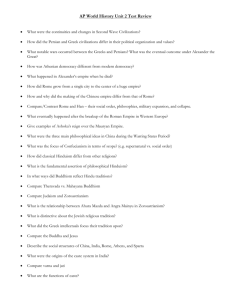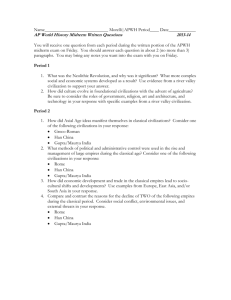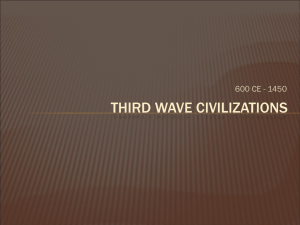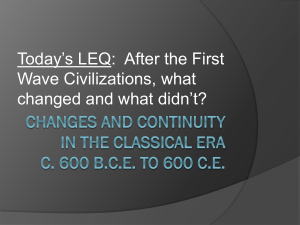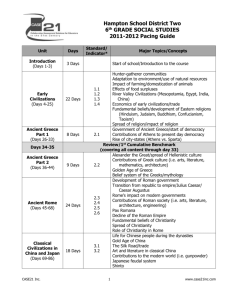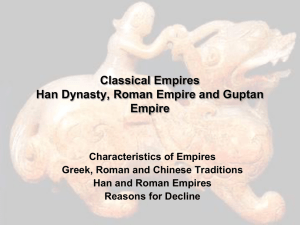Standards/ - North Arlington School District
advertisement
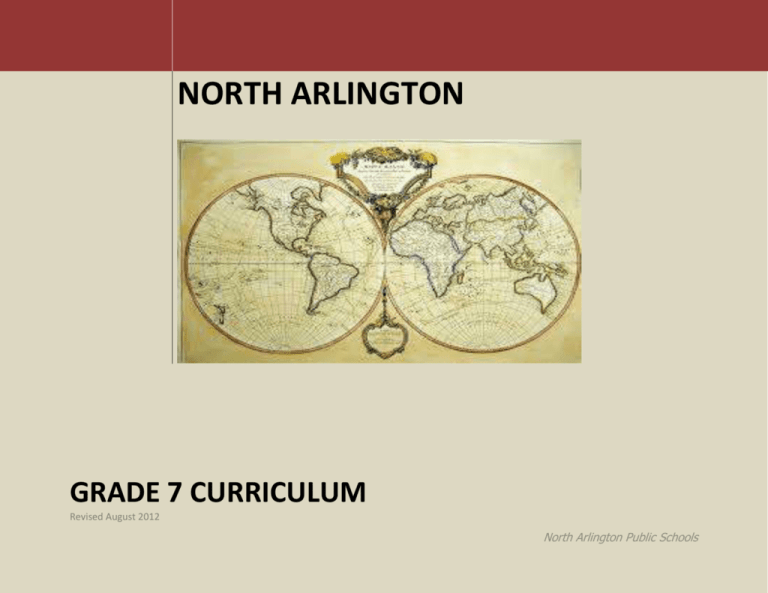
NORTH ARLINGTON GRADE 7 CURRICULUM Revised August 2012 North Arlington Public Schools Content Area SS Target Course/Grade level Grade 7 Unit Title The Roman World Essential Questions How did Rome become the dominant power in the Mediterranean region? Why did the Roman Empire fall and what is its legacy? Unit Overview The students will learn about the rise and fall of Rome while studying about the spread of Christianity throughout the region. 6.2.8.A.3.a Compare and contrast the methods (i.e., autocratic rule, philosophies, and bureaucratic structures; communication and transportation systems) used by the rulers of Rome, China, and India to control and unify their expanding empires. 6.2.8.A.3.b Compare and contrast the rights and responsibilities of free men, women, slaves, and foreigners in the political, economic, and social structures of classical civilizations. 6.2.8.A.3.c Determine the foundational concepts and principles of Athenian democracy and the Roman Republic that later influenced the development of the United States Constitution. 6.2.8.B.3.a Determine how geography and the availability of natural resources influenced the development of the political, economic, and cultural systems of each of the classical civilizations and provided motivation for expansion. Lessons and Activities The learning experiences that will facilitate engagement and achievement Unit Learning Targets As a result of this segment of learning, students will… Standards/ CPI’s Students will learn about the Roman Empire grew from a small city to a powerful empire. Students will analyze the importance of legend, geography and politics in the growth of Rome. Students will learn about the conversion of Rome from a republic to an empire. Students will analyze religion in the empire and the growth of Christianity into Rome’s official religion. Students will understand how internal and external factors caused the collapse of the Roman Empire. Discussion Independent learning Group work Map review Evidence of Learning Formative and Summative measures Homework Test Quiz Project Assessment Group work Resources Books, articles, text, etc. Text book Homer (1998). The Iliad. N.Y.C., N.Y.: Penguin Classics . ISBN 0140275363 Homer (1997). The Odyssey. N.Y.C., N.Y.: Penguin Classics. ISBN 0140268863 “Gladiator” (2000) North Arlington Public Schools 6.2.8.C.3.a Analyze the impact of expanding land and sea trade routes through the Mediterranean Basin, India, and China. 6.2.8.C.3.b Explain how the development of a uniform system of exchange facilitated trade in classical civilizations. 6.2.8.C.3.c Explain how classical civilizations used technology and innovation to enhance agricultural/manufacturing output and commerce, to expand military capabilities, to improve life in urban areas, and to allow for greater division of labor. 6.2.8.D.3.a Compare and contrast social hierarchies in classical civilizations as they relate to power, wealth, and equality. 6.2.8.D.3.c Determine common factors that contributed to the decline and fall of the Roman Empire, Gupta India, and Han China. 6.2.8.D.3.d Compare the golden ages of Greece, Rome, India, and China, and justify major achievements that represent world legacies. 6.2.8.D.3.e Compare and contrast the tenets of various world religions that developed in or around this time period (i.e., Buddhism, Christianity, Confucianism, Islam, Judaism, Sikhism, and Taoism), their patterns of expansion, and their responses to the current challenges of North Arlington Public Schools globalization. 6.2.8.D.3.f Determine the extent to which religions, mythologies,and other belief systems shaped the values of classical societies. North Arlington Public Schools Content Area SS Target Course/Grade level Grade 7 Unit Title Islamic and African Civilizations Essential Questions How were Muslim leaders able to spread Islam and create and empire? What factors shaped early African civilizations? Unit Overview The students will learn about the rise and spread of Islam and it directly affected the kingdoms of West Africa. 6.2.8.A.4.a Analyze the role of religion and other means rulers used to unify and centrally govern expanding territories with diverse population. 6.2.8.B.4.a Explain how geography influenced the development of the political, economic, and cultural centers of each empire and well as the empires’ relationships with other parts of the world. 6.2.8.B.4.b Assess how maritime and overland trade routes (i.e., the African caravan and Silk Road) impacted urbanization, transportation, communication, and the development of international trade centers. 6.2.8.B.4.c Determine how Africa’s physical geography and natural resources posed challenges and opportunities for trade and development. 6.2.8.B.4.d Explain why the Arabian Peninsula’s physical features and location made it the epicenter of Afro-Eurasian trade and fostered the spread of Islam into Africa, Europe, and Asia. Lessons and Activities The learning experiences that will facilitate engagement and achievement Unit Learning Targets As a result of this segment of learning, students will… Standards/ CPI’s Students will learn about the beginnings of Islam in Arabia with Muhammad. Students will understand the laws and traditions of the Islamic faith as outlined in the Qur’an. Students will learn about how Islam shaped three major empires while making important contributions to science, art and literature. Students will analyze the culture, trade, resources and everlasting influence West African societies had on the world. Discussion Independent learning Group work Map review Evidence of Learning Formative and Summative measures Homework Test Quiz Project Assessment Group work Map work Resources Books, articles, text, etc. Text book Qur’an excerpts Examples of Islamic art and architecture History.com video “Hajj” North Arlington Public Schools 6.2.8.B.4.e Analyze the motivations for civilizations to modify the environment, determine the positive and negative consequences of environmental changes made during this time period, and relate these changes to current environmental challenges. 6.2.8.C.4.e Determine the extent to which interaction between the Islamic world and medieval Europe increased trade, enhanced technology innovation, and impacted scientific thought and the arts. 6.2.8.D.4.b Analyze how religion both unified and divided people. 6.2.8.D.4.c Analyze the role of religion and economics in shaping each empire’s social hierarchy, and evaluate the impact these hierarchical structures had on the lives of various groups of people. 6.2.8.D.4.i Explain how and why Islam spread in Africa, the significance of Timbuktu to the development and spread of learning, and the impact Islam continues to have on African society. North Arlington Public Schools Content Area SS Target Course/Grade level Grade 7 Unit Title Empires of Asia and the Americas Essential Questions How did China change after the fall of the Han Dynasty? How did the Japanese blend borrowed customs and native traditions into a unique culture? What led to the development of complex societies in the Americas? Unit Overview The students will learn about the history and culture of the people of China, Japan and the early Americas. 6.2.8.B.3.a Determine how geography and the availability of natural resources influenced the development of the political, economic, and cultural systems of each of the classical civilizations and provided motivation for expansion. 6.2.8.D.3.e Compare and contrast the tenets of various world religions that developed in or around this time period (i.e., Buddhism, Christianity, Confucianism, Islam, Judaism, Sikhism, and Taoism), their patterns of expansion, and their responses to the current challenges of globalization 6.2.8.D.3.f Determine the extent to which religions, mythologies, and other belief systems shaped the values of classical societies. 6.2.8.A.4.a Analyze the role of religion and other means rulers used to unify and centrally govern expanding territories with diverse populations. Lessons and Activities The learning experiences that will facilitate engagement and achievement Unit Learning Targets As a result of this segment of learning, students will… Standards/ CPI’s Students will learn about the unification and rise of China under the Sui, Tang and Song Dynasties. Students will analyze the importance of Confucian thought and Chinese self rule. Students will learn about how Japan rose in power isolated from Chinese and Korean influence. Students will analyze the rise and decline of the Maya, Aztec and Inca civilizations Students will understand how European settlers effected the lives of American civilizations. Discussion Independent learning Group work Map review Evidence of Learning Formative and Summative measures Homework Test Quiz Project Assessment Group work Map work Resources Books, articles, text, etc. Text book Conquistador diaries Murasaki Shikibu (1990), The Tale of Genji. Vintage. NYC. ISBN 0679729534 History.com video “Genghis Khan: Terror and Conquest” North Arlington Public Schools 6.2.8.B.4.a Explain how geography influenced the development of the political, economic, and cultural centers of each empire and well as the empires’ relationships with other parts of the world. 6.2.8.B.4.b Assess how maritime and overland trade routes (i.e., the African caravan and Silk Road) impacted urbanization, transportation, communication, and the development of international trade centers. 6.2.8.B.4.c Determine how Africa’s physical geography and natural resources posed challenges and opportunities for trade and development. 6.2.8.B.4.e Analyze the motivations for civilizations to modify the environment, determine the positive and negative consequences of environmental changes made during this time period, and relate these changes to current environmental challenges. 6.2.8.B.4.f Explain how the geographies of China and Japan influenced their development and their relationship with one another. 6.2.8.B.4.h Explain how the locations, land forms, and climates of Mexico, Central America, and South America affected the development of Mayan, Aztec, and Incan societies, cultures, and economies. 6.2.8.C.4.a Explain the interrelationships among North Arlington Public Schools improved agricultural production, population growth, urbanization, and commercialization. 6.2.8.C.4.b Analyze how trade, technology, the availability of natural resources, and contact with other civilizations affected the development of empires in Eurasia and the Americas. 6.2.8.D.4.a Explain how contact between nomadic peoples and sedentary populations had both positive and negative political, economic, and cultural consequences. 6.2.8.D.4.b Analyze how religion both unified and divided people. 6.2.8.D.4.e Assess the demographic, economic, and religious impact of the plague on Europe. 6.2.8.D.4.g Analyze the immediate and long-term impact on China and Europe of the open exchange between Europe and the Yuan (Mongol) Dynasty. Content Area SS Target Course/Grade level Grade 7 Unit Title Renewal in Europe Essential Questions How did life in Europe change after the fall of Rome? How did religion affect Europe’s political and social life during the later Middle Ages? What political and economic changes led to the Renaissance? North Arlington Public Schools Unit Overview The students will learn about life during the Middle Ages, the Renaissance and the Reformation. 6.2.8.A.4.a Analyze the role of religion and other means rulers used to unify and centrally govern expanding territories with diverse population. 6.2.8.B.4.a Explain how geography influenced the development of the political, economic, and cultural centers of each empire and well as the empires’ relationships with other parts of the world. 6.2.8.D.4.c Analyze the role of religion and economics in shaping each empire’s social hierarchy, and evaluate the impact these hierarchical structures had on the lives of various groups of people. 6.2.8.D.4.f Determine which events led to the rise and eventual decline of European feudalism. Lessons and Activities The learning experiences that will facilitate engagement and achievement Unit Learning Targets As a result of this segment of learning, students will… Standards/ CPI’s Students will understand why different ways of life developed in Europe. Students will assess why Europe was a dangerous place after the fall of Rome. Students will explain the obligations of government and people of the era Students will analyze the importance of religion in everyday life no matter the social class. Students will study the Renaissance’s beginnings and how it changed Europe for the better. Discussion Independent learning Group work Map review Evidence of Learning Formative and Summative measures Homework Test Quiz Project Assessment Group work Map work Resources Books, articles, text, etc. Text book Science article on The Black Death History.com video “The Crusades: Crescent and the Cross” History.com video “Humanism Triggers the Renaissance” North Arlington Public Schools North Arlington Public Schools
